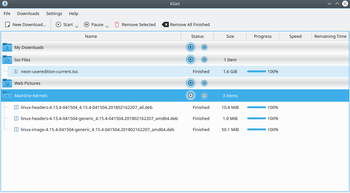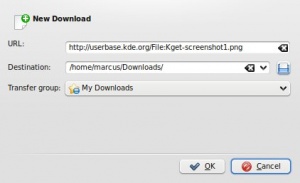KGet: Difference between revisions
The madman (talk | contribs) Added image. |
Re-branding edit |
||
| Line 3: | Line 3: | ||
{|style="text-align:center" | {|style="text-align:center" | ||
|[[Image:Kget-screenshot1.png|thumb|350px|Kget is downloading a file]]||'''KGet is the Download-Manager | |[[Image:Kget-screenshot1.png|thumb|350px|Kget is downloading a file]]||'''KGet is the Download-Manager for KDE software.''' | ||
|} | |} | ||
Revision as of 17:09, 29 December 2009
Template:I18n/Language Navigation Bar
 |
KGet is the Download-Manager for KDE software. |
Features
- Downloading files from FTP and HTTP(S) sources.
- Pausing and resuming of downloading files, as well as the ability to restart a download.
- Tells lots of information about current and pending downloads.
- Embedding into system tray.
- Integration with the Konqueror web browser.
- Metalink support which contain multiple URLs for downloads, along with checksums and other information.
Using KGet
There are a number of ways to start-up and use KGet. You can do it manually from the application menu (Search for, "KGet", or find it under the Internet category). You can also set it as the default download manager for Konqueror, which will start it automatically when you wish to download a file. Selecting the options under the KGet tool-bar button in Konqueror will start it automatically as well.
There are a number of ways to use KGet to download a file from the internet as well: clicking a Download link for a file will automatically start it; right-clicking on any web-page element and navigating to Actions --> Download with KGet will initiate a download of that element with KGet (this also works for files and folders on remote storage devices); showing the drop-target and click-dragging a link or file to it will automatically start a download; and click-dragging a link or file to the main window will automatically start a download.

